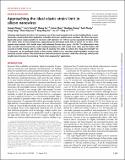| dc.contributor.author | Zhang, H. | |
| dc.contributor.author | Tersoff, J. | |
| dc.contributor.author | Xu, S. | |
| dc.contributor.author | Chen, H. | |
| dc.contributor.author | Zhang, Q. | |
| dc.contributor.author | Zhang, K. | |
| dc.contributor.author | Yang, Y. | |
| dc.contributor.author | Lee, C.-S. | |
| dc.contributor.author | Tu, K.-N. | |
| dc.contributor.author | Lu, Y. | |
| dc.contributor.author | Li, James | |
| dc.date.accessioned | 2018-02-15T16:11:13Z | |
| dc.date.available | 2018-02-15T16:11:13Z | |
| dc.date.issued | 2016-08 | |
| dc.date.submitted | 2015-10 | |
| dc.identifier.issn | 2375-2548 | |
| dc.identifier.uri | http://hdl.handle.net/1721.1/113684 | |
| dc.description.abstract | Achieving high elasticity for silicon (Si) nanowires, one of the most important and versatile building blocks in nanoelectronics, would enable their application in flexible electronics and bio-nano interfaces. We show that vapor-liquid-solid-grown single-crystalline Si nanowires with diameters of ~100 nm can be repeatedly stretched above 10% elastic strain at room temperature, approaching the theoretical elastic limit of silicon (17 to 20%). A few samples even reached ~16% tensile strain, with estimated fracture stress up to ~20 GPa. The deformations were fully reversible and hysteresis-free under loading-unloading tests with varied strain rates, and the failures still occurred in brittle fracture, with no visible sign of plasticity. The ability to achieve this "deep ultra-strength" for Si nanowires can be attributed mainly to their pristine, defect-scarce, nanosized single-crystalline structure and atomically smooth surfaces. This result indicates that semiconductor nanowires could have ultra-large elasticity with tunable band structures for promising "elastic strain engineering" applications. | en_US |
| dc.publisher | American Association for the Advancement of Science (AAAS) | en_US |
| dc.relation.isversionof | http://dx.doi.org/10.1126/SCIADV.1501382 | en_US |
| dc.rights | Attribution-NonCommercial 2.0 Generic (CC BY-NC 2.0) | en_US |
| dc.rights.uri | https://creativecommons.org/licenses/by-nc/2.0/ | en_US |
| dc.title | Approaching the ideal elastic strain limit in silicon nanowires | en_US |
| dc.type | Article | en_US |
| dc.identifier.citation | Zhang, H. et al. “Approaching the Ideal Elastic Strain Limit in Silicon Nanowires.” Science Advances 2, 8 (August 2016): e1501382–e1501382 © 2016 The Authors | en_US |
| dc.contributor.department | Massachusetts Institute of Technology. Department of Materials Science and Engineering | en_US |
| dc.contributor.department | Massachusetts Institute of Technology. Department of Nuclear Science and Engineering | en_US |
| dc.contributor.mitauthor | Li, James | |
| dc.relation.journal | Science Advances | en_US |
| dc.eprint.version | Final published version | en_US |
| dc.type.uri | http://purl.org/eprint/type/JournalArticle | en_US |
| eprint.status | http://purl.org/eprint/status/PeerReviewed | en_US |
| dc.date.updated | 2018-02-09T18:20:47Z | |
| dspace.orderedauthors | Zhang, H.; Tersoff, J.; Xu, S.; Chen, H.; Zhang, Q.; Zhang, K.; Yang, Y.; Lee, C.-S.; Tu, K.-N.; Li, J.; Lu, Y. | en_US |
| dspace.embargo.terms | N | en_US |
| mit.license | PUBLISHER_POLICY | en_US |
